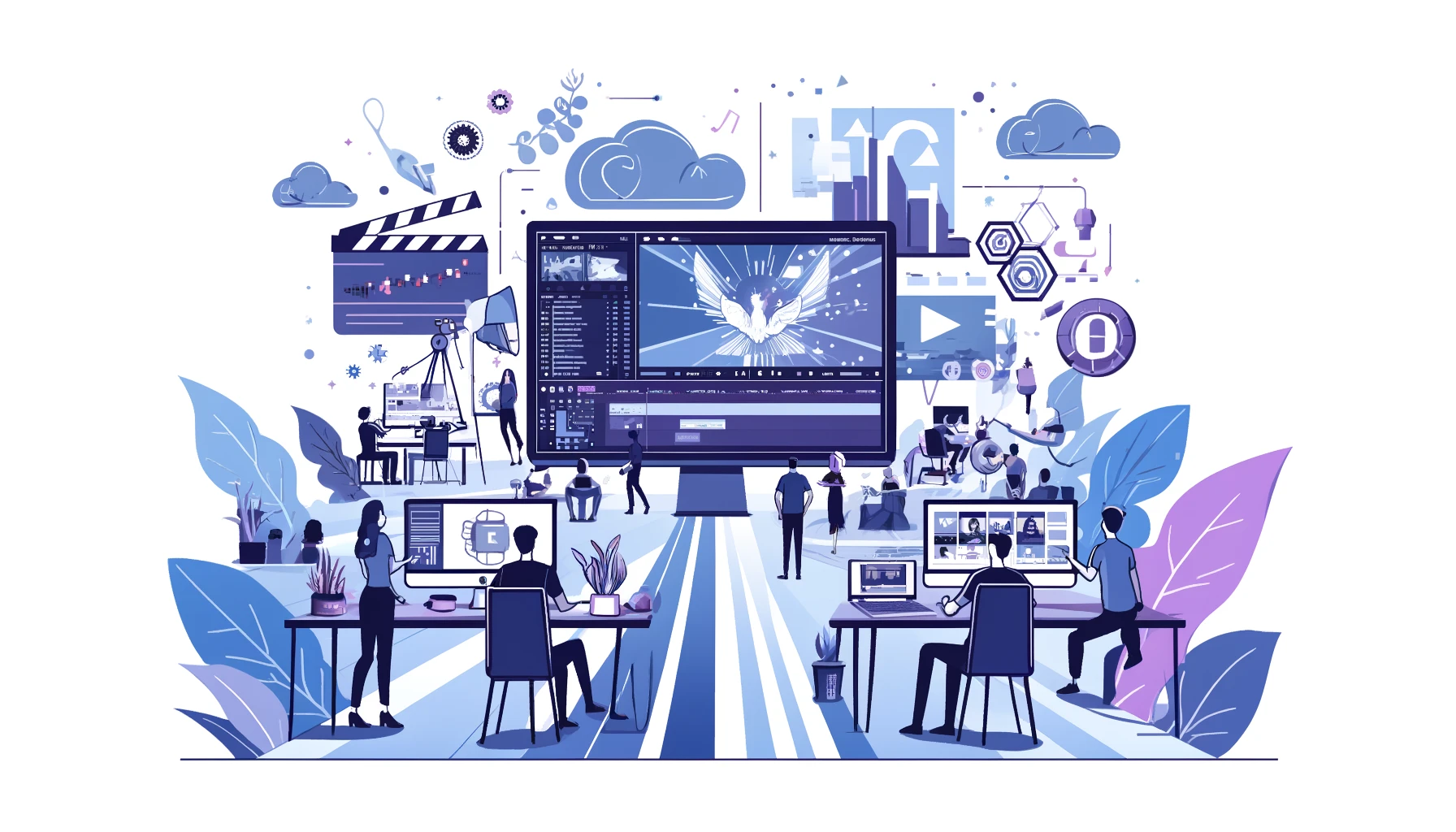
Create AI videos with 230+ avatars in 140+ languages.
Video consumption goes up every year, and people are 52% more likely to share videos than any other type of content.
Any business can benefit from video creation. From marketing videos to internal training, the range of applications is limitless!
Suppose you’ve been postponing video marketing because you don’t know how to get started or think you’re not good “enough”. In that case, the following information should give you a friendly (and helpful) nudge and some excellent pointers in the right direction!
In today’s blog post, you’ll grasp the essential tips for beginners that you can use to create professional-looking videos today!
1. Plan your video from the start to guarantee quality
When you’re a newbie and hurry to start shooting, there are so many factors to account for. So, plan your video like a pro, and you’ll boost the video quality to the point where creating professional videos is a breeze.
Our ultimate tip for any beginner creator: Use frameworks and templates to get crystal-clear on your entire video project before you film a single minute of footage. The FOCA framework, for instance, will help you structure your video and ensure you leave nothing out.
Walk through all the steps to ensure you create a successful video, from analyzing your audience to reaching your desired outcome. It makes everything so much easier you’ll be sorry you haven’t discovered it earlier.
2. Invest time in writing a winning script
The script is the crucial backbone for your video. An excellent video script should be tailored to your target audience and present information in an easy-to-follow format.
Depending on your needs, there's various different strategies for scripting a professional video. Here are some of our favorites:
✅ List the key points and ideas they want to cover in bullet point format: This technique can help you focus on your video topic. It's best suited when you don't need to create a complete script because you are filming a simple demonstration or an "over the shoulder" style video tutorial.
✅ Turn your bullet points into a written script: It's worth going the extra mile to write a script when creating an explainer video, a how-to video, teaching a concept, or advertising your product.
✅ Add your dialogue, action, and camera angles: This screenplay format is best for larger productions where you'll be filming multiple scenes. Most high-end adverts are scripted in this manner.
✅ Sketch out a complete storyboard: A storyboard (or even an animatic) gives you a visual idea of your script's appearance once it's filmed. It's essentially a sketch of what each scene will look like. You only need a storyboard when working with high-quality animations or TV-grade content.
3. Use online video tools to bypass expensive editing software
Online video makers are a game-changer for beginners because they enable you to make professional videos without technical skills.
These tools completely bypass the need to learn editing software and often have easy-to-use templates, drag-and-drop stock videos, royalty-free music, text overlays, and templates. And if you've never tried making your own content before, there'll be plenty of tutorials to assist you with the post-production.
Below is a video that shows you how to use Synthesia to create videos using human AI talking avatars.
You could also try other tools such as Canva for simple presentations, or Powtoon for animated videos.
4. Make time to find or film a variety of visual elements
One shot that never changes makes for a boring video. To keep the viewer's attention, consider what kind of stock elements you can find, or how you'll use b-roll footage to add visual interest.
Try out different camera angles, lighting setups, and editing techniques to see what looks most visually appealing.
5. Consider making your own template
You’ll probably need to make more than one video. So, a custom template is critical to giving your entire video creation a cohesive look and feel. When your template is ready to go with all your brand elements, it’s easier to produce consistent, high-quality videos fast.
Start by creating a style guide that outlines your brand's colors, fonts, and other visual elements. Then, use a video editor to create a custom template incorporating these elements. This template can serve as the foundation for all of your videos.
👉 Don’t know how to start making your template? This guide will give you two options to start creating templates today.
6. Deliver confident narration in front of the camera
Stage fright is real, and rest assured, many beginners struggle with camera presence.
Here are a few tips to help you perform in front of a camera:
- Make sure the camera angle is flattering to your face. There's a lot to be said for using natural light sources effectively and selecting the correct camera lens! The more you work to make you look good on screen, the more comfortable and confident you'll feel delivering the script.
- If you feel like you keep going blank, or struggle to remember a script, then consider using a teleprompter. Sure, it can take a bit of getting used to, but a teleprompter can really help with your performance in the long-term.
- Audio quality is really important in making you sound good. Invest in a good microphone and you'll be amazed at how much more professional your voiceover sounds.
But what if you're still struggling? Are you supposed to start taking acting classes? There's another solution that works really well for training videos: use an AI avatar.
You can either choose from a selection of diverse avatars that are based on human actors, or create your own custom avatar that's based on recorded footage of yourself. With an avatar, there's no need to film yourself!
7. Try text-to-speech tools when you need fast narration
The voice over's tone and delivery impact your video's overall mood and effectiveness. A well-delivered voiceover conveys the right emotion, adds context, and engages your viewers.
Using an AI voice generator for narration is a great way to speed up the time it takes to make a video. You simply type out your script and have it read aloud by a computer-generated voice. This means you can create personalized videos at scale with minimal effort.
8. Add captions to improve accessibility
Adding closed captions to your videos increases viewership, accessibility, and reach.
Some people are deaf or hard of hearing. Others may be hiding from their bosses while watching your videos at work. Or they may be trying to watch while waiting in a quiet area 🤫
From this perspective, accessibility is enormous because it removes the obstacles and enables your viewers to watch and understand in any context.
To you can do many other things to make your online content more accessible for people with disabilities, consider checking W3C’s guide — the World Wide Web Consortium established these international standards for web accessibility beginning in 1999.
To get more specific tips directly applicable to your video creation, check out these 12 tips for making accessible video content.
9. Pay attention to pacing when editing
Pacing helps to create a cohesive, engaging, and impactful viewing experience, and if you get it right, you’ll significantly improve the perceived quality of your videos.
You don’t want your video to move too slowly because viewers may lose interest. And you don’t want it to move too fast either because it can be overwhelming. So, when editing your content, aim for a natural pace that keeps the story moving forward.
Consider the length of each shot, the timing of cuts, and the overall rhythm of your video. With practice, you'll be able to develop a sense of pacing that works best for your content.
10. Review your video for clarity and brevity
When editing your content, focus on creating a cohesive and compelling story, smooth transitions between scenes and music that sets the right tone.
Remove any footage that doesn't contribute to the story. Be ruthless and only keep the essential shots. Do the same with the audio, eliminating the background noise.
Editing is time-consuming, so be patient and don't rush through it. Consider doing it in multiple rounds, just like you would do with editing content. Each round you edit, you concentrate on a specific outcome, such as color correction or audio levels.
Create video content using an AI avatar
Follow these tips and you could have a more than decent video ready today! Your audience won’t even be able to tell you’re a beginner 😉.
Get started by creating a free AI video.
About the author
Strategic Advisor
Kevin Alster
Kevin Alster heads up the learning team at Synthesia. He is focused on building Synthesia Academy and helping people figure out how to use generative AI videos in enterprise. His journey in the tech industry is driven by a decade-long experience in the education sector and various roles where he uses emerging technology to augment communication and creativity through video. He has been developing enterprise and branded learning solutions in organizations such as General Assembly, The School of The New York Times, and Sotheby's Institute of Art.











.png)




